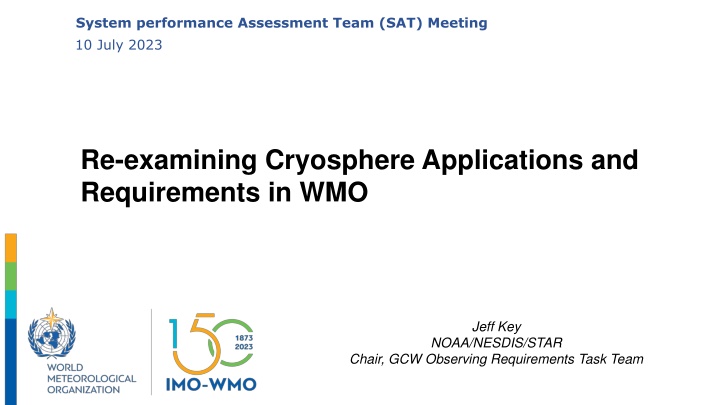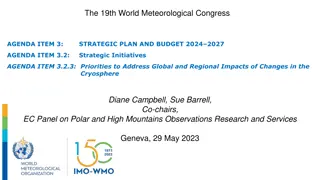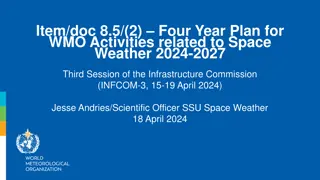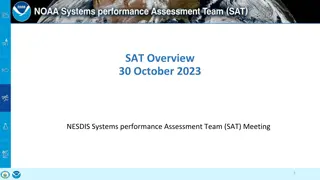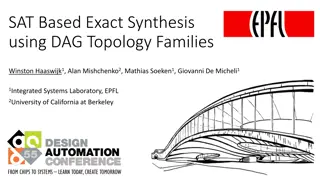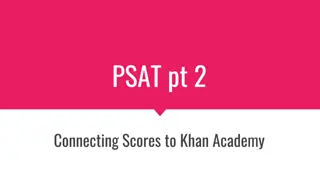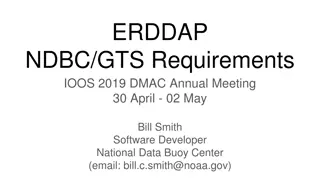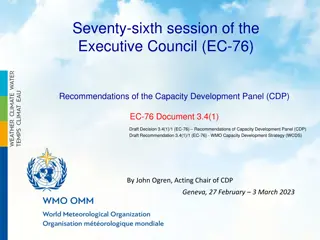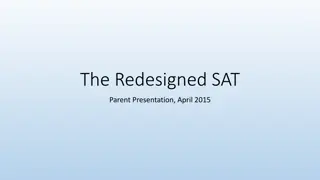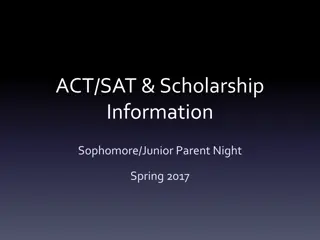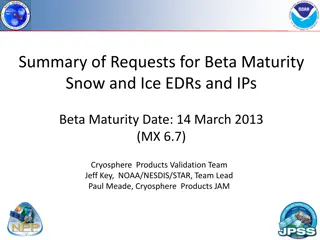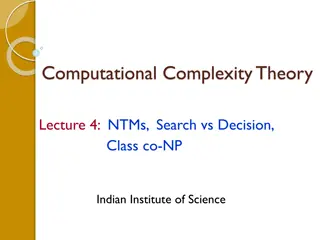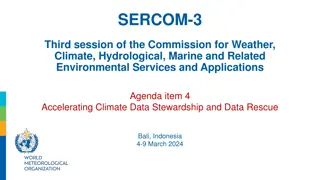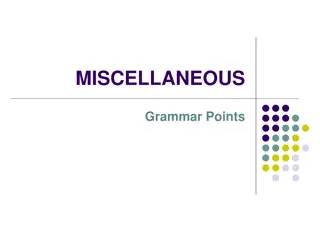Re-examining Cryosphere Applications and Requirements in WMO - SAT Meeting Summary
The System Assessment Team (SAT) meeting on 10th July 2023 revolved around re-evaluating cryosphere applications and requirements within WMO. Jeff Key from NOAA/NESDIS/STAR chaired the meeting, focusing on updating and expanding observational requirements for the cryosphere. The cryosphere, encompassing various frozen water elements, plays a vital global role, with WMO's historical emphasis dating back 150 years. The ongoing project aims to enhance the cryosphere observing system, providing crucial insights and recommendations over the next 1.5 years.
Download Presentation

Please find below an Image/Link to download the presentation.
The content on the website is provided AS IS for your information and personal use only. It may not be sold, licensed, or shared on other websites without obtaining consent from the author.If you encounter any issues during the download, it is possible that the publisher has removed the file from their server.
You are allowed to download the files provided on this website for personal or commercial use, subject to the condition that they are used lawfully. All files are the property of their respective owners.
The content on the website is provided AS IS for your information and personal use only. It may not be sold, licensed, or shared on other websites without obtaining consent from the author.
E N D
Presentation Transcript
System performance Assessment Team (SAT) Meeting 10 July 2023 Re-examining Cryosphere Applications and Requirements in WMO Jeff Key NOAA/NESDIS/STAR Chair, GCW Observing Requirements Task Team
Disclaimers 1. I am not an official spokesperson for WMO. Don t be misled by the WMO slide template. 2. You, the SAT, might be expecting to hear/see detailed requirements for observing the cryosphere. Instead, this presentation is about WMO s efforts to update and expand the current observational requirements, and to provide gap analyses and recommendations for improving the cryosphere observing system. It is a project that will take at least 1.5 more years to complete. But first, a little background on the cryosphere 2
The cryosphere collectively describes elements of the earth system containing water in its frozen state and includes: solid precipitation, snow cover, sea ice, lake and river ice, glaciers, ice caps, ice sheets, ice shelves, permafrost and seasonally frozen ground. The cryosphere is global, ~100 countries
The NESDIS Cryosphere River and lake ice Ice sheets, ice caps, ice shelves Sea ice Permafrost and seasonally-frozen ground Snow Glaciers
WMO has had a focus on the cryosphere for 150 years 2ndIMO Congress (1879) - Resolution : Congress requested that observations at high elevation and of glaciers length and thickness be organized and data shared, to aid in the solution of problems that may present themselves in the future. 2021 GCW in INFCO M 1879 2nd International Meteorological Congress: Cg-14 (2007) EC-PORS 2013-2022 PPP Cg-IV(1963): the 1stEC Standing Committee on Antarctic Cg-16 (2011) GCW Cg-17 (2015) EC-PHORS Cg-19 2024-27: Draft SO 1.5 Draft Res 3.2(3): Cryosphere Priorities GCW Global Cryosphere Watch, EC WMO Executive Council; EC-P(H)ORS EC expert panel on Polar (and High Mountain) Observations, Research, and Services, Cg-xx World Meteorological Congress session xx, INFCOM Infrastructure Commission, PPP Polar Prediction Project 8
Cryosphere Priorities in WMO/INFCOM INFCOM2 (2022), Resolution 4: 3 - Infrastructure roadmap to a fully integrated cryosphere in Earth system models 4 - Enhance the availability of cryosphere observations in WIGOS 5 - Cryosphere data in the WMO Unified Data Policy 6 - Cryosphere data: standardization and increased access through WIS 7 - Integrate cryosphere specific functions in GDPFS/WIPPS 8 - Systematic approach to cryosphere-related hazards in the DRR framework 9 - Cryosphere in the Global Climate Observing System (GCOS) 10 - Roadmap for Research to Services for Polar and High-Mountain Regions 11 - Further research on key questions on the cryosphere and its impacts 12 - Access to cryosphere space-based products: engagement with space agencies WIGOS - WMO Integrated Global Observing System, GDPFS - Global Data-processing and Forecasting System, WIPPS - WMO Integrated Processing and Prediction System, DRR Disaster Risk Reduction
The Rolling Review of Requirements (RRR): Requirements, Gaps, Statement of Guidance SoG Space SoG Atmosphere OSCAR Requirements SoG Ocean Synthesis and recommendations to Members on evolution of observing systems Review of Technology Free User Requirements per Earth System Domain Gap Analysis SoG Hydrosphere/ Terrestrial SoG Cryosphere OSCAR Surface & OSCAR Space Current and Planned Capabilities POCs for AAs SoG Integrated Earth System The Point of Contact (POC) for each Application Area (AA) facilitates a consensus for requirements on observations and submits them to OSCAR (Observing Systems Capability Analysis and Review Tool).
Historical Note A compilation and consolidation of observational requirements and capabilities for the cryosphere was done and published in a report of the Integrated Global Observing Strategy (IGOS) in 2007. Available at https://stratus.ssec.wisc.edu/igos/docs/cryos_theme_report.pdf
The Rolling Review of Requirements (RRR) Cryosphere Earth System Application Category (ESAC) and its Application Areas ESAC AA AA AA 5. Cryospheric Applications 5.1 Terrestrial Cryosphere Forecasting and Monitoring INFCOM/AG-GCW 5.2 Sea-Ice Forecasting and Monitoring 5.3 Cryospheric Climate Monitoring INFCOM/AG-GCW INFCOM/AG-GCW INFCOM/AC-GCW in collaboration with GCOS/TOPC, OOPC INFCOM/AC-GCW in collaboration with SERCOM/SC-DRR AA 5.4 Cryospheric Disaster Risk Reduction
The GCW Pilot Study The objectives of the GCW pilot study are to follow the RRR process for terrestrial snow and sea ice*. The process includes the following elements: a) a review of technology-free Members' requirements for observations, within an area of application covered by WMO programmes and co-sponsored programmes; a review of the observing capabilities of existing and planned observing systems, both surface- and space-based; a Critical Review of the extent to which the capabilities (b) meet the requirements (a), i.e., gaps; and a Statement of Guidance based on (c) for all Application Areas considered within the category. b) c) d) *While the original plan was to address only terrestrial snow cover, we had already started work on sea ice and will address terrestrial snow later.
GCW has a Task Team Specifically for this: CRYORA CRYORA mandate: develop cryosphere observing requirements and related guidance in the new RRR. CRYORA Team and SMEs: Jeff Key lead, NOAA Thomas Lavergne GCOS ECV Stefan Kern - GCOS ECV/OOPC Penelope Wagner Met Norway, IICWG Petra Heil Australian Antarctic Div, IPAB/IABP Luzmila Gomez Argentinian Hydrographic Service, IICWG Alejandro de la Maza Chile Navy, IICWG Vasily Smolyanitsky Arctic&Antarctic RCC Steffen Tietsche ECMWF Keld Qvistgaard SC-MMO Sean Helfrich NOAA Ludovic Bruckner NOAA/NIC Chris Derksen - ECCC Expert Teams: Cryosphere and Polar Observations (ET-CPO) Cryosphere and Polar Data Interoperability (ET-CPDI) Sea Ice Watch (ET-SIW) Snow Watch (ET-SW) Task Teams: Cryosphere Observing Requirements (CRYORA) Glaciers and Ice Caps (GIC-TT) Permafrost (P-TT) Coordinators: GCW Best Practices Coordinator (GCW-BPC) Polar Regional Climate Centres Focal Point (GCW-PRCC-FP) Cryosphere Bulletin Coordinator (CBC) GCW National Focal Points
The CRYORA Process, Step 1: Literature Review Reviewed at least 30 high-level documents for user needs (variables and requirements). Appendix 1: CRYORA References Allen, S., H. Frey, and C. Huggel. (2017). Assessment of Glacier and Permafrost Hazards in Mountain Regions. Technical Guidance Document. 10.13140/RG.2.2.26332.90245. Bippus G., T. Nagler, S. Schiller, K. Luojus, and D. Gustafsson. 2016. Snow, Freshwater Ice, and Glacier information. CryoLand. 49pp. Bring, A., I. Fedorova, Y. Dibike, L.Hinzman, J. M rd, S. H. Mernild, T. Prowse,O. Semenova, S. L. Stuefer, and M.-K. Woo(2016), Arctic terrestrial hydrology: A synthesis of processes, regional effects, and research challenges, J. Geophys. Res.Biogeosci.,121,621 649, doi:10.1002/2015JG003131. etc.
Step 2: Identify User Applications Applications as they appear in the literature have been tabulated. Weather Prediction NWP (Numerical Weather Prediction)/Nowcasting Global NWP High Res NWP Nowcasting / VSRF Weather Research Weather Forecasting Operations AOPC Synopic Met Atmospheric Research Ocean Applications Ocean Apps Marine Met Services Species/Organisms and Food Web Change Research Ocean State and Coastal Zone Change Research Sea Ice Change Research Ice Sheet/Glacier Change Research CLIVAR GOOS Oil Ecosystem Change Research Risk Management/Disasters/Hazards/Engineering Engineering Design / Risk Management / Emergency Response Oil Climate Change Adaptation Operations Avalanches Environmental Impact Assessment Engineering Design Operations Planning Route Planning Safe Navigation and Operations Risk Management Emergency Response Search and Rescue Operations Operations Planning Environmental Impact Assessment Snow Change Research Ecosystem Change Research Ocean State and Coastal Zone Change Research Land Surface and Use Change Research Sea Ice Change Research River/Lake Ice Change Research Ice Sheet/Glacier Change Research Permafrost Change Research TOPC Weather Research Weather Forecasting Operations Climate . Transportation/Navigation . Agriculture . Coastal Applications / Sea Level Rise Coastal Apps Species/Organisms and Food Web Change Research Ecosystem Change Research Ocean State and Coastal Zone Change Research Land Surface and Use Change Research Sea Ice Change Research Ice Sheet/Glacier Change Research River/Lake Ice Change Research Permafrost Change Research CLIVAR TOPC Hydrology/ Water Resources Hydrological Monitoring Hydrological forecasting/prediction Snow Change Research Land Surface and Use Change Research River/Lake Ice Change Research Ice Sheet/Glacier Change Research Permafrost Change Research CliC/GEWEX GCOS/TOPC
Step 3: Sea Ice Variables and User Applications x Note: This not a complete list
Step 3: Snow Variables and User Applications Equivalent Note: This not a complete list
Step 4: Mapping CRYORA Application Areas and Variables to WMO Earth System Application Categories/Areas Some variables within GCW Areas will map to multiple WMO Application Categories/Areas and have different requirements Not a trivial task! GCW Draft Application Areas Earth System Application Category Weather Space Weather Ocean Atmospheric Coastal / Sea Level Rise Ocean Climate Hydrological / Terrestrial Hydrology / Water Resources Cryospheric* Agriculture Integrated Earth System Apps Risks/Disasters/ Hazards/Eng Literature Review for Requirements and Variables Transportation/ Navigation * All GCW Application Areas map to Cryospheric App Category Arrows not drawn to simplify illustration
Which are Sea Ice? (2) (1) (3) Which of these pictures show sea ice? X The pictures on the right and below are not of sea ice. What are they? (Answer in the chat) (From earthobservatory.nasa.gov) (7) (4) (5) X (6) X The NOAA Observer s Guide to Sea Ice has lots of information on sea ice types.
Step 5: Determining Essential Sea Ice Variables Tactical (10-500m resolution, now to days ahead) (5.2) x x x x x x x x x x Strategic (days ahead, sub-km resolution)) (5.2) x x x x Short-term planning (km resolution, < 1 year ahead) (5.2) x x x x x x Long-term planning (> 3km res, years ahead) (5.3): GCOS IP x x x x x x Stage of development Velocity /Drift Concentration Thickness Sea ice temperature Surface albedo Pressure Divergence/convergence Sea Ice strength Ridges (surface characteristics) Icebergs (position?) Leads and polynyas Floe size Snow thickness Age Stage of melt Melt pond fraction x x x x x x x x x x x x x x x Note: Items in yellow are variables already in OSCAR Requirements, which are to be updated.
Updating OSCAR: Nomenclature is Important Current OSCAR Req Proposed changes (GCW) Sea-ice freeboard (cm m) GCOS Sea Ice ECV products Sea-ice elevation Sea-ice surface temperature Sea-ice temperature (K) Sea Ice Temperature Sea-ice thickness (cm m) Sea-ice thickness Sea Ice Thickness Sea-ice cover Sea-ice concentration Sea Ice Concentration (%): Sea-ice velocity (km*d-1 m * s-1) Sea-ice motion Sea Ice Drift (km/d): Sea ice type age, roughness, density, etc Sea Ice Age (d): Sea ice characteristics sea-ice surface albedo, meltpond fraction, meltpond length scales, relevant snow (on sea ice) variables Sea Ice Surface Albedo (l): Snow Depth on Sea Ice (m):
Step 6: Determining Priorities and Gaps Why is there a gap and what are we going to do about it? A portion of the CRYORA sea ice gaps worksheet:
Status of Pilot Project GCW is engaged in a pilot study to assess gaps for the Sea Ice Forecasting and Monitoring application area. We are adding Cryospheric Climate Monitoring based on recent work for GCOS. Terrestrial snow will come later. Status of the activity: Formed a GCW Task Team for this activity, CRYORA, building on the work of the IGOS Cryosphere Theme. Performed a literature review to assess user needs (variables, requirements) and applications; Compiled tables of variables, applications, requirements, and sources; Done Map applications from the literature to RRR Earth System Application Categories and Application Areas, and reconcile findings with the JET-EOSDE RRR structure; Prioritize variables (only sea ice so far); In progress Consolidate and refine numerical requirements; Compile gaps, impact, and recommendations. Prepare a Statement of Guidance (SoG). Just started
